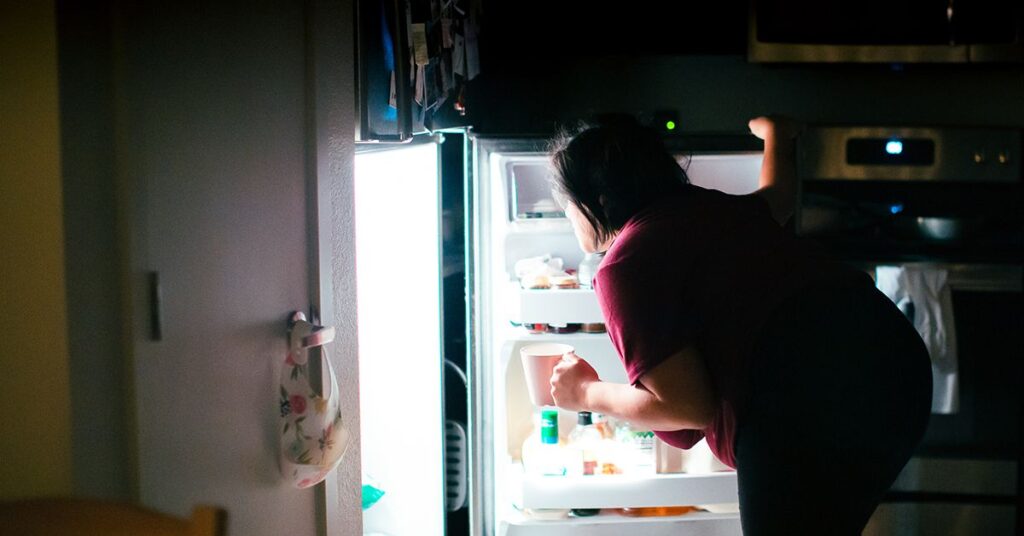Sleep-eating disorders, like nocturnal eating syndrome (NES) and sleep-related eating disorder (SRED), may cause people to eat more than they desire at night. However, treatments are available.
There are a few eating disorders that are specifically linked to sleep or nighttime.
NES causes people to consume most of their food at night, often with frequent sleep interruptions. In the case of SRED, people aren’t conscious while eating and don’t remember their actions.
Although these disorders may feel overwhelming or scary to experience, there is support available. Here’s what to know.
There are three types of eating disorders that may be linked to sleep. They are:
Sleep-related eating disorder
SRED is a type of parasomnia condition that causes people to wake up in the night and eat while they’re still asleep. It’s essentially a form of sleepwalking (somnambulism) with an emphasis on eating. Afterward, people can’t recall their nightly activities.
Since those with SRED are unconscious while eating, there’s a risk that they may consume toxic or dangerous substances or injure themselves while attempting to prepare food.
Nocturnal eating syndrome
NES causes people to eat excessively at night or wake up in the night to eat. A 2021 review explains how those with NES typically believe that eating at night will help them fall back asleep. Unlike SRED, those with NES are awake and conscious while eating.
Binge eating disorder
Binge eating disorder (BED) causes people to eat large quantities of food even when they don’t feel hungry. While it’s not a nocturnal disorder, some with BED may binge specifically at night.
In a 2023 study of 1,296 university students in Saudi Arabia, 81% of whom had at least one parasomnia disorder, 7.6% had SRED. The researchers found it to be the least common of the parasomnias.
According to a 2022 review, NES has an estimated prevalence of 1% to 2%. It’s especially common in those with obesity or those undergoing any form of bariatric surgery. NES is also strongly associated with depression, low sleep quality, and having the urge to wake up in the night, according to 2021 research.
The National Institutes of Health (NIH) states that BED is the most common eating disorder in the United States. It affects about 1.25% of adult women and 0.42% of adult men, as well as approximately 1.6% of adolescents.
Learn more about BED statistics here.
Symptoms of SRED include:
eating at night and not remembering doing soconsuming food you wouldn’t normally eatpotentially eating dangerous substancespotentially accidentally injuring yourself while sleepwalking and eatinghaving no appetite in the morninghaving daytime fatiguegaining weight
SRED often occurs with other sleep conditions, like sleepwalking, restless legs syndrome, obstructive sleep apnea, or narcolepsy.
Symptoms of NES include:
having the urge to eat when waking up at nighthaving the urge to eat between dinner and bedtimeconsuming most of your food at nightbelieving that food helps you fall asleephaving depressionhaving low sleep qualityhaving no appetite in the morninggaining weight
Conditions that may occur with NES include obesity, anorexia nervosa, bulimia nervosa, or BED. According to one 2016 review, stress is a common trigger of NES.
Also, another 2016 review found that NES is especially prevalent among university students, who may also experience significant stress, endure peer pressure, and follow a low nutrition diet.
Symptoms of BED include:
eating quicklyeating to the point of being uncomfortably fulleating large amounts of food even if you don’t feel hungryhiding your eating habits due to shame or embarrassmentexperiencing feelings of guilt, distress, or disgust about eating
If you receive a diagnosis of a sleep-eating disorder or think you may have one, it’s important to know that you’re not alone and that there’s help available.
Treatment options for SRED include:
stopping or changing prescription medications that may cause or exacerbate symptoms, like antipsychotics, antidepressants, or zolpidem, which treats insomniaminimizing stress levels through techniques like mindfulness, meditation, breathwork, and yogalocking the fridge or cupboards or using an alarmpracticing good sleep hygiene, like avoiding blue light or meditating before bedusing a sleep diary to track your sleep patterns and potential triggersvisiting a sleep specialistpotentially taking the medication topiramate, which treats migraine episodes and seizures, though it may cause side effects
Treatment options for NES include:
Treatment options for BED include:
cognitive behavioral therapy, which one 2016 review concluded is very effective at treating BEDSSRIsthe medication topiramatethe medication lisdexamfetamine, which is an effective BED treatmentusing a diary to track your binge eating triggers
Sleep-eating disorders can significantly affect your health and quality of life, but effective treatments are available. Whether you’re dealing with SRED, NES, or BED, options range from cognitive behavioral therapy and medications to lifestyle changes and stress management techniques.
By seeking professional help and exploring these treatment options, you can take important steps toward recovery and improved well-being.

